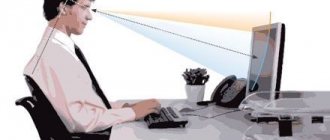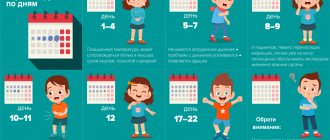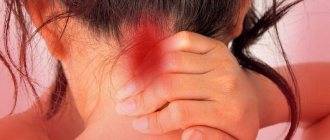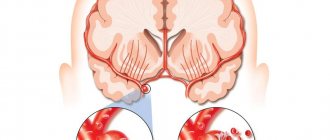Causes of cluster pain
Cluster headaches are thought to occur when the trigeminal nerve, which supplies sensation to the facial area, is stimulated. In turn, the nerve is activated under the influence of the hypothalamus, a part of the brain that regulates the functioning of the autonomic nervous system, endocrine glands, and ensures the functioning of the body’s “biological clock.”
There are some known factors that lead to cluster headaches:
- Season. In most patients, exacerbations occur in spring and autumn. Sometimes they are mistakenly mistaken for symptoms of hypovitaminosis or seasonal allergies.
- Heredity. People who have sick relatives have an increased risk.
- Smoking. Approximately 65% of patients are smokers. However, giving up a bad habit does not improve the condition.
- Excessive alcohol consumption.
Don't self-diagnose! Only a neurologist can understand the causes of your symptoms and prescribe the correct treatment.
Who is at risk?
These are men over 40 and women over 60. This type of headache is especially popular among smokers and alcohol drinkers. Genetic predisposition and previous traumatic brain injuries matter a lot.
Today, doctors increasingly note that the disease is typical for patients with sleep disorders, that is, patients with apnea.
Symptoms
Cluster headaches occur at the same time, 1-3 times a day (in some patients they can occur once every 2 days, in others - up to 8 times a day). Often an attack causes a person to wake up at night. Painful sensations increase over 5-10 minutes and can last from 15 minutes to 3 hours (usually 30-90 minutes).
The nature of the pain is burning, stabbing, throbbing or pressing. It is stronger and more painful than a migraine. The patient cannot sit still and walks back and forth. The attack can be so severe that during it the person contemplates suicide.
Pain is localized on one side, usually behind and around the eye, spreading to the temple, forehead, cheeks, nose, and upper jaw.
Symptoms that may occur during an attack on the side of pain:
- drooping eyelid;
- redness of the eye;
- constriction of the pupil;
- half of the nose is stuffy;
- lacrimation;
- swelling, sweating on half of the face.
As a rule, a series of attacks lasts for weeks or months, and then disappears completely for a while, after which they return again.
Take care of yourself, book a consultation now
Message sent!
expect a call, we will contact you shortly
Read also
Planning pregnancy in patients with migraine
In recent years, many women suffering from migraine have turned to the prevention and treatment of migraine during pregnancy.
Conscious responsibility for one’s health, the desire to reproduce healthy… Read more
Trigeminal neuralgia
Trigeminal neuralgia is a chronic disease characterized by excruciating paroxysmal shooting pains in the area of innervation of one or more branches of the trigeminal nerve. Neuralgia…
More details
Overuse headache (Headache caused by excessive medication)
Frequent headaches are a good reason to immediately contact a neurologist. Otherwise, you can miss the onset of a serious illness or lead yourself to the formation of an abusive headache...
More details
Monoclonal antibodies against migraine
About 11% of people in the world suffer from migraines, and a third of them are forced to stay in bed during attacks. This significantly reduces the quality of life: it interferes with work, communicating with friends and engaging in hobbies.…
More details
Migraine
Migraine or headache seriously worsens a person's condition, especially with frequent attacks - chronic migraine. At the same time, people often do not take migraine seriously, not even thinking about seeing a doctor.…
More details
Treatment of cluster headaches
To relieve a painful attack, triptans - drugs for the treatment of migraines - and inhaling oxygen through a mask for 12 minutes are usually used. The doctor may also recommend other medications: ergotamine, lidocaine nasal spray.
There are medications that can shorten the series of headaches and reduce their severity. The neurologist will select the appropriate medications for you and tell you how to take them correctly.
In severe cases, if drug therapy does not help, surgical treatment methods are resorted to. These techniques involve blocking the trigeminal nerve fibers that transmit pain impulses.
Contact a neurologist. Your doctor will prescribe the best treatment to help keep cluster headaches under control. Make an appointment with a specialist now by calling +7 (495) 230-00-01
The material was prepared by Natalya Yurievna, a neurologist at the international clinic Medica24, Candidate of Medical Sciences Lasch.
Treatment of attacks
If you are faced with attacks of this kind, you should not delay visiting a doctor. After all, such a debilitating and intense headache soon leads to neurosis and depression.
The leading treatment for a series of pain attacks is oxygen therapy (intravenous administration of an ozonized solution, oxygen inhalation).
During the “cluster” period, the attending physician selects the course and dosage of glucocorticosteroids, which allows for a significant reduction in pain.
Doctors at the First Neurology Children's Center will help you cope with this disease and bring you back to life without pain.
Treatment tactics
Treatment of cluster headache is a pressing issue that is being actively studied in modern neurological practice. Optimization of treatment regimens and principles allows you to achieve lasting and effective results. At the moment, there are two independent and mandatory treatment approaches for each patient. The first approach is analgesic symptomatic therapy aimed at symptomatic treatment, i.e. relief of an acute attack of cluster headache. The second principle is preventive treatment to prevent recurrence of a series of attacks of cluster pain. Unfortunately, it is currently impossible to completely cure the disease, however, with supportive corrective therapy, lasting results can be achieved.
Anesthesia
Analgesic therapy consists of prescribing potent analgesic drugs with a central mechanism of action. Such drugs belong to the group of narcotic drugs and are used only for treatment in a hospital setting. The use of pure oxygen has also shown high effectiveness in relieving an attack of cluster pain. During an attack, the patient is given 100% oxygen by inhalation, which reduces the intensity of the pain syndrome.
Prevention
Prevention of cluster headaches involves the use of complex therapy aimed at improving the rheological properties of the blood, maintaining the cardiovascular and nervous system, as well as the use of glucocorticosteroids.
They use drugs from the group of angioprotectors and neuroprotectors, which significantly increase the metabolic activity of the brain and prevent dystrophic disorders in the central nervous system. Lithium preparations are also used to improve the functioning of the hypothalamic-pituitary system and normalize electrochemical and neurotransmitter processes in the brain.
Clinical Brain Institute Rating: 4/5 — 16 votes
Share article on social networks
What can trigger cluster pain?
Episodes often occur during rest. For this reason, doctors recommend avoiding daytime naps, which can trigger an attack. Also, pain more often occurs in the evening, after a working day, at night, 1.5-2 hours after falling asleep. For many, the problem appears at certain times of the day, and for some people it is tied to the cycles of the seasons.
Substances that can provoke cluster pain in those who are already sick:
- histamine;
- a nicotinic acid;
- nitroglycerine;
- vasodilator medications;
- alcohol.
Possible causes of pain in the right eye and head
For effective treatment, it is necessary to determine the cause of the headache and right eye pain. The most common and least dangerous are fatigue, abnormal physical activity, mental or emotional stress. These conditions provoke an increase in blood pressure and vascular spasm, which are relieved by proper rest and taking antispasmodic drugs. However, if your head and right eye regularly hurt, this may indicate a number of chronic diseases - treatment for each of them is prescribed individually.
Migraine
A headache attack that occurs without a specific cause is called a migraine. It is often unilateral, spreading to the left or right side of the head, neck and eyes. It can last from several hours to several days, and in many patients it develops in several stages. Before an attack, an aura is felt - characteristic signs by which one can determine the imminent onset of pain, but it may be absent. Additional symptoms that indicate a migraine include:
- nausea and dizziness;
- digestive disorders;
- pain in the eyes, increased intraocular pressure;
- visual disturbances, the appearance of dots or circles before the eyes.
A separate type of disease is ocular migraine. Its main symptoms are associated with deterioration of visual acuity, blurred vision, pain in and behind the eyes. Treatment consists of taking special anti-migraine medications.
Cluster pain in the right eye and head
Cluster pain is highly intense, but is rare. They appear at certain periods and may be associated with changing weather conditions in spring or autumn. The patient has pain on the right side of the head and right eye, the sensation may spread to the temples of the neck. The pain is often unilateral, but can also be symmetrical. It is accompanied by additional signs:
- impaired and deteriorating vision;
- nasal congestion;
- the appearance of shadows or dots in the field of view;
- lacrimation, especially in bright light;
- drooping of the upper eyelid.
The exact cause of cluster pain is unknown. An acute attack lasts no more than 10 minutes, then the pain decreases, but persists for up to 3 hours. Symptoms often appear daily, at certain times of day.
Trochleitis
Inflammation of the oblique muscle of the eye is trochleitis. With this disease, the patient has a headache, and painful sensations also appear in the right eye (in the inner corner or above the eyeball). Trochleitis does not develop independently; more often it is a characteristic symptom of a number of autoimmune diseases. It manifests itself in patients with lupus erythematosus, rheumatoid arthritis, Behcet's disease, lymphoma and other dangerous chronic pathologies. The pain is prolonged, can provoke migraine attacks, its intensity can vary from mild to very severe. Treatment is aimed at the underlying diseases, the main goal being to stabilize the patient's condition.
Glaucoma
Another disease that causes headaches and pain in the right eye is glaucoma, or increased intraocular pressure. It may be of hereditary origin; patients with diabetes mellitus, chronic hypertension, myopia and chronic pathologies of the cardiovascular system are also at risk. The disease may not show any symptoms in the first stages, but is then accompanied by the following changes:
- headache, its source is in the right or left eye;
- deterioration of peripheral vision;
- the appearance of circles, spots or other elements before the eyes;
- watery eyes, especially when trying to look at a bright light.
There are two main forms of glaucoma. Open-angle is associated with myopia and in the initial stages occurs without a pronounced clinical picture, then it is dangerous due to chronic pain and loss of peripheral vision. Closed-angle glaucoma develops with farsightedness. Without timely treatment, it can lead to damage to the optic nerve and blindness.
Occipital neuralgia
Headache on the right, eye and neck - these are the main symptoms of occipital neuralgia. It develops with mechanical damage, inflammation or destruction of the occipital nerve. The pain is sharp, throbbing, reminiscent of electrical discharges. The attacks begin and pass abruptly and can begin with careless head movements or prolonged stay in an uncomfortable position. They may also be accompanied by pain in the eyes, nausea, and decreased sensitivity of the skin in the neck and head. Treatment consists of eliminating the cause of neuralgia and taking painkillers.
Inflammation of the optic nerve
Optic neuritis is an inflammation of the optic nerve that can lead to complete loss of vision. The process is accompanied by its outer layer - the myelin sheath, as a result of which it cannot transmit nerve impulses. Signals do not reach the brain, so information cannot be processed correctly. Pain in the right side of the head and eye may indicate the first stage of nerve damage. Neuritis also causes characteristic symptoms:
- pain in the right side of the head and eyes, which intensifies when the angle of vision changes;
- impaired perception of the color spectrum;
- blurred vision.
Optic neuritis rarely occurs as an independent disease. More often it becomes one of the symptoms of other systemic pathologies, including multiple sclerosis and neuromyelitis.
Inflammation of the sinuses
The head hurts, pain appears in the right eye, and discharge appears from the nose - these signs may indicate sinusitis. The disease is accompanied by fever, deterioration in general health and cough, which is why it must be distinguished from colds and flu. The main cause of sinusitis is a viral, bacterial or fungal infection in the paranasal sinuses; it can also be caused by allergic reactions.
You can pre-determine sinusitis at home. If you tilt your head down sharply, acute pain will appear. She talks about the presence of exudate in the nasal sinuses, while normally they are filled with air. Treatment is selected individually and includes taking antibiotics, nasal rinsing and taking symptomatic medications.
Neck diseases
Headache in the right eye can also be associated with diseases of the cervical spine. Here pass important vessels and nerves that go to different parts of the brain. Their compression or damage leads to poor circulation, pain in the head that radiates to the right eye, as well as other symptoms.
- Osteochondrosis is a chronic disease of cartilage, in which it becomes insufficiently strong and elastic and cannot absorb movement. Its main causes are poor nutrition, age-related changes, consequences of injuries, instability and abnormal location of the vertebrae. Osteochondrosis causes constant pain in certain areas of the head, which spreads to the shoulder girdle and arms. The danger of the disease is that it is constantly progressing, and treatment can only stop its development.
- Displacement of the vertebrae is a change in their normal configuration relative to each other. They can become displaced due to injuries and falls, as well as as a result of kyphosis and other types of curvature. The innervation of certain areas is disrupted, which leads to the formation of zones of ischemia (insufficient oxygen supply).
- Protrusion is the initial stage of a hernia. It is a protrusion of the intervertebral disc in a certain direction. The degree of its displacement is proportional to the stage of protrusion. Patients have pain in the right eye and the right side of the head, and it is difficult to turn in this direction. The main focus of pain is in the neck; x-rays and MRI data will help make a final diagnosis.
It is important to periodically examine the condition of the cervical spine, on the advice of doctors at the Clinical Brain Institute. Simple tests will allow you to determine the location of the vertebrae and intervertebral discs, and assess the condition of blood vessels and nerves. If these diseases are diagnosed in the early stages, there is a high probability of complete recovery and preventing their further development.
Diagnosis of cluster headache
Migraine symptoms (sound and light sensitivity, nausea, aura, vomiting) are the main reasons for misdiagnoses.
Keeping a diary by the patient describing headaches can help the doctor make the correct diagnosis. The patient should describe to the doctor the following points:
- characteristics of pain (throbbing, stabbing);
- frequency of attacks (frequency, date, time of each attack);
- duration of pain;
- localization of pain;
- pain intensity (on a five-point scale below);
- additional symptoms (nausea, vomiting, sweating);
- any measures that bring relief (going out into fresh air, measuring blood pressure);
- any events preceding or causing the attacks;
- any medications you are taking;
- your emotional state during the attack (excitement, anxiety);
- sleep disturbance, snoring, daytime sleepiness.
What to do if you suspect cluster pain in yourself or your loved ones?
It is important to consult an experienced doctor and talk about your symptoms in detail. European statistics show that the majority of patients who suffer from the disease are not correctly diagnosed for several months or even years. This seriously worsens the patient's condition and affects his life. Before making a diagnosis, a thorough examination is necessary, because brain aneurysms or hematomas can cause similar symptoms.
It is important to distinguish: chronic paroxysmal hemicrania
This disease is similar to cluster pain, but is 8 times more common in women. The main difference is the course without remissions and exacerbations. The pain may be burning, boring or throbbing. Most often the attack lasts 10-15 minutes, but in some patients it lasts up to 16 hours. The number of attacks is usually greater than with cluster pain: some patients may have more than ten per day. Chronic paroxysmal hemicrania is treated better than cluster pain. Patients are prescribed indomethacin. The drug effectively stops and prevents attacks.
Symptomatic picture
Patients at risk are tall and have well-developed muscles. Personal qualities combine high ambition with internal helplessness and indecision. During attacks, cephalalgia occurs abruptly and immediately reaches a peak. On average, each episode can last about an hour, and can range from 15 to 180 minutes, after which they suddenly stop. Attacks begin mainly at night. The exacerbation period for a typical cluster headache ranges from two weeks to two months.
The symptomatic picture of each attack includes unilateral burning or cutting cephalalgia. It is most often localized on the left side. The epicenter is the area of the eyeball. Patients describe it as a feeling of “tearing the eye” or “pressing the eye from the inside.” Irradiation is noted in the ear, cheek, and teeth on the affected side. There are trigger zones, pressure on which increases the pain. These include the splenius muscles of the head and neck, and the trapezius muscle. Pain may radiate to the shoulders, scapula, and neck ipsilaterally. In a third of cases, photophobia and vomiting are noted.
A characteristic clinical sign of PHB is the inability to maintain a stationary horizontal position, since slight physical activity partially relieves pain. During an attack, the patient rushes about, punches the walls or claps his hands. In addition, there are autonomic disorders such as hypoactivation of the sympathetic and increased tone of the parasympathetic system. This is expressed in hyperhidrosis of the orbital region, nasal congestion and mucus discharge, conjunctival hyperemia, hypersalivation, Horner's syndrome, which includes enophthalmos, ptosis and miosis ipsilaterally.









